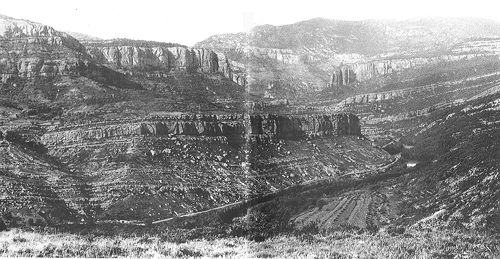
Lenticular sedimentary bodies
Plate 10

Lenticular sedimentary bodies
Plate 10
Vertical cliffs interrupt the milder slopes of this landscape in the Spanish Pyrenees. Outcrops of conglomerate (cemented gravel) make them. Conglomerate bodies are more resistant to erosion than the rocks they are interbedded with (clays and sandstones). Their lateral variation of thickness (wedging) can thus be appreciated. When wedging is observed on one side only, the body is called a tongue or a wedge; a lens tapers out on both sides (we are speaking of sections, i.e., bidimensional views). The lateral closure of a lenticular or wedge-shaped body, where base and top converge, is the termination. A depositional termination (there is no truncation above) is a pinch-out. If the body splits laterally into several tongues, it interfingers, or intertongues, with an adjacent body.
Sedimentary bodies are made of several beds, which are not always apparent, especially in the case of sandstones and conglomerates, because of uniform cementation and vertical "amalgamation" (see Introduction, figure 8 C ). The geometry of individual beds may conform or not to that of the enclosing body (examples will be shown in plates 11 and 12).
The lens-shaped conglomerates of this picture represent fossilized alluvial fans, fluvial sedimentary bodies accumulated at the termini of mountain valleys in Tertiary (Oligocene) time. Torrential streams excavated these valleys and carried coarse sized detritus to a main valley or a plain located in a wide subsiding basin. Fans derive their name by the lateral expansion of stream currents flowing from mountain valleys and the radial shifting of channels.
Exposures like this, occurring near Pobla de Segur, Spain, are rather exceptional: the lack of tectonic deformation, the scarcity of vegetation, and the strong cementation of some rock types make them possible. The road at the bottom of the valley gives an approximate idea of the scale, which is comparable with that of a seismic section.